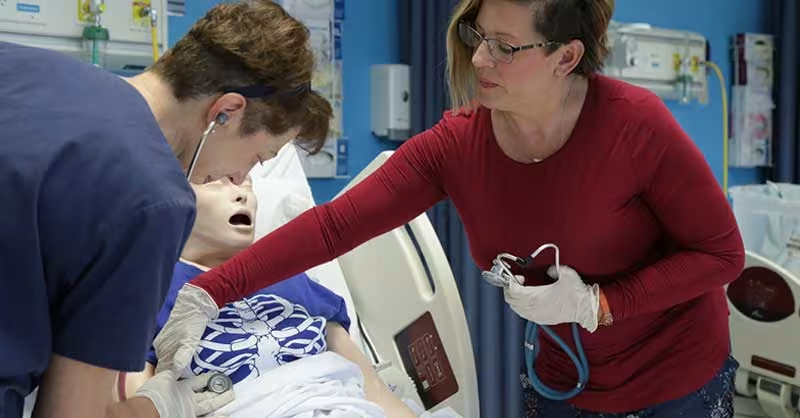The Role of Simulation in Nursing Education
Each blog post is dated and contains accurate information as of that date. Certain information may have changed since the blog post publication date. If you would like to confirm the current accuracy of blog information, please visit our ABSN program overview page or contact us at 866-890-9467.
Simulation in nursing education allows nursing students to practice their skills in a safe environment under a supervisor. They work with high-tech manikins to perform typical nursing duties in a hospital-like setting before they apply those skills to clinical practice in the real world.

As an ABSN student, nursing simulations serve a vital purpose in your clinical skills development. These realistic learning activities challenge you to collaborate, problem-solve, and apply clinical reasoning when caring for diverse patient populations. Best of all, you’ll learn in a low-stress environment where you can make mistakes and practice your skills without affecting real patients.
Simulation Scenarios
During Xavier University’s 16-month ABSN program, which spans four semesters, or eight terms, you’ll experience at least one simulation per term. By the end of the program, you’ll have completed between 10 and 12 nursing simulation labs, which cover everything from adult health to mental health to pediatrics.
As your online-based ABSN curriculum advances, so does the complexity of our simulations. During the first semester, you’ll participate in two simulations that focus on patient safety, physical assessments, and skills application. These basic labs set the foundation for course-specific simulations designed to build your skill level over time.
By the final semester, you’ll encounter complex simulations that require you to care for patients with multifaceted health care needs. For example, you may find yourself performing a physical assessment and clinical intervention on an elderly male patient with a history of chronic renal failure who is suffering from shortness of breath and showing signs of a heart attack.

Safe Environment
Set up like a hospital environment, the two nursing simulation rooms inside our ABSN Learning Center have everything you need to play the role of nurse in various patient care scenarios. As you work to hone your skills, we want you to feel like you’re in a real-life situation without the fear of harming someone.
Even though you’re required to participate in every nursing simulation lab experience, we never grade you on your performance. Simulations serve as pure learning opportunities. If grades were involved, students would focus on defending their performance instead of taking an open, honest look at their actions. The role of simulation in nursing education is to provide you a safe space to make mistakes you can learn from.

Learn more about why Xavier University is known for nursing.
Collaborative Care
Nurses must work hand in hand with other health-care staff members to produce the best possible patient outcomes. We emphasize the importance of team-based, interdisciplinary care by having you participate in simulations with up to three other nursing students, each of you playing a distinct role.
You may play the primary nurse role, while your peers act as secondary nurse, scribe, and family member. As the primary nurse, it’s up to you to determine the best course of action for the patient and then delegate tasks and communicate accordingly.
Nursing simulations also bring learning consistency to the ABSN curriculum. There’s no guarantee a particular skill-related experience will present itself during your in-hospital clinical rotations. Our nursing simulation labs ensure you’re exposed to a wide range of patient challenges.
Reality Check
After each role-play experience, there’s a debriefing to discuss your performance — the learning component of the simulation. Debriefing allows you to reflect on the simulation with your instructor in an open, honest setting. By having you mull over the experience, your instructor can reinforce learning objectives and correct misconceptions.

Because every simulation is recorded, you’re able to watch your performance first-hand during the debrief. The simulation video enables you and your instructor to dissect a specific action that took place and work to understand what you were thinking and feeling at that moment. Let’s say you showed signs of distress as the patient was bleeding; your instructor can help you resolve unsettled feelings.
Like the simulation itself, the debrief is intended to be a safe experience for students. It’s a lesson in learning where there is no criticism, only constructive feedback. After all, it’s important for you to feel good about your progress in the program and approach the next simulation with enthusiasm.

Here’s everything you need to know about preparing for the first semester of nursing school.
Simulated Vs. Standardized
Simulation can involve patient simulators or standardized patients (real people). In our nursing simulation labs, we use one or the other, depending on the learning objectives of a scenario.
Anne, our simulation manikin, will be your patient in most of the medical-based scenarios, especially those considered high-risk. While Anne won’t suffer from you making a clinical error, she will be vocal if she doesn’t like your treatment approach. Through a SimPad System, faculty can control her physical actions and emotional responses during a simulation.
Scenarios having a more interpersonal component, such as a mental health simulation, require standardized patients to create the best possible social interaction experience.
Better Outcomes
Simulations have a positive impact on nursing education and the quality of patient care. Not only do these activities let you demonstrate your skills in a contextual learning environment, they also foster critical thinking and improved clinical judgment. You’ll be amazed by how much you learn when given the opportunity to intervene in clinical situations where there is low risk.

Contact an admission counselor to learn more about how our nursing simulations labs play a vital role in your clinical skills development.

ABSN 101 Guide
Download our ABSN 101 Guide to help you successfully navigate the accelerated path to nursing.
